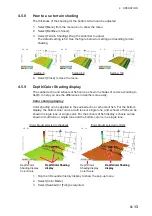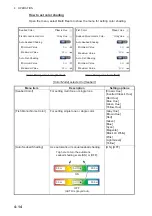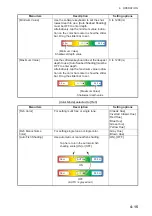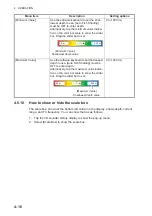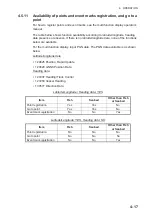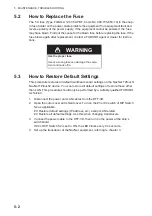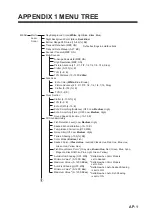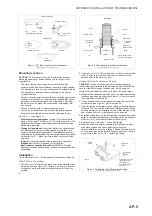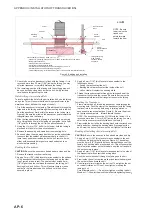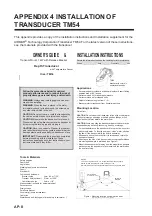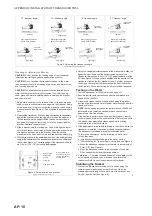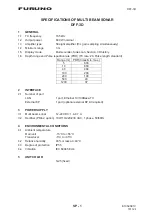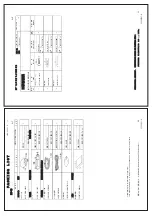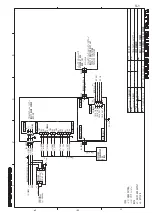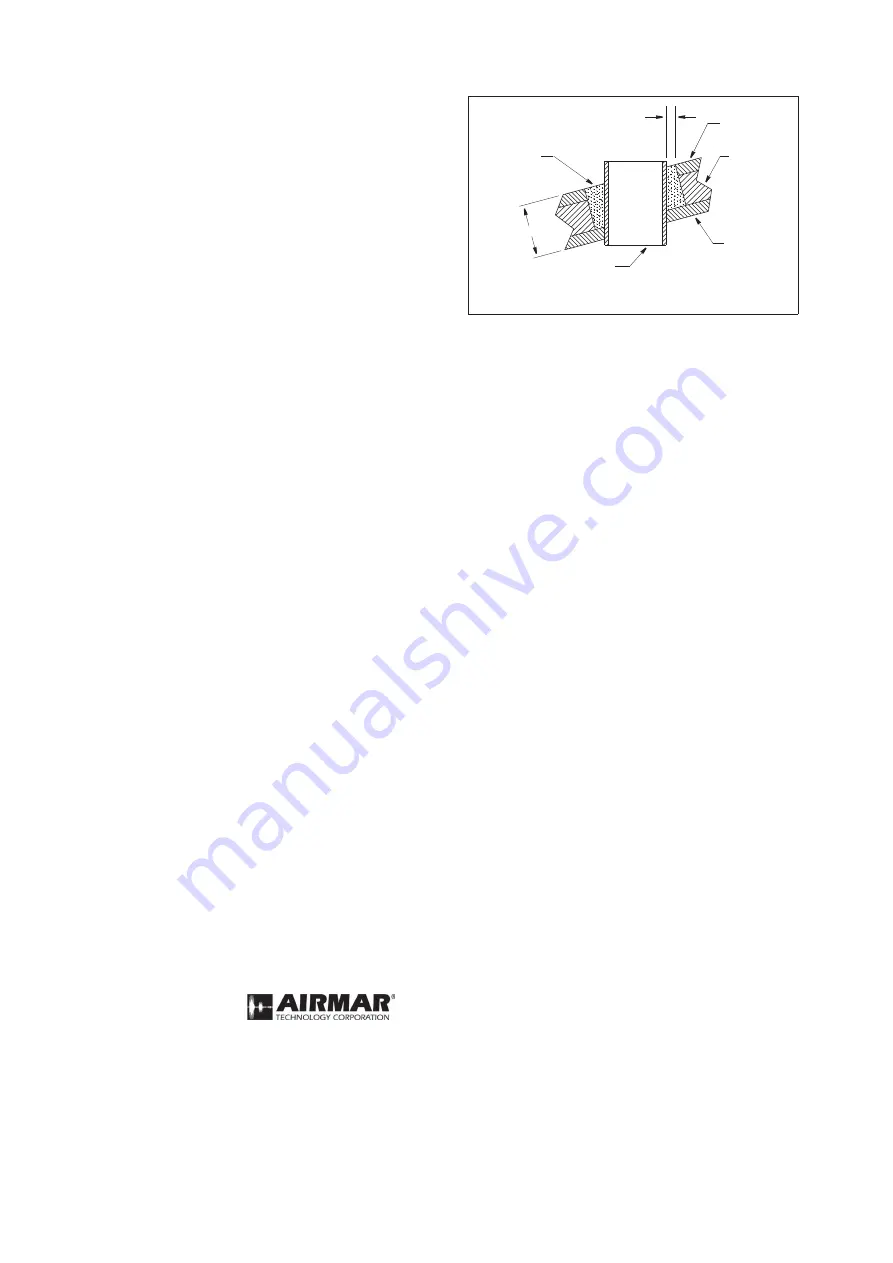
APPENDIX 3 INSTALLATION OF TRANSDUCER B54
AP-7
4
6. Use marine sealant to half-fill the hollow in the yellow triangular
plug. Apply a 2mm (1/16") thick layer of marine sealant to the
three sides of the plug that form the triangle. The sealant will
hold the plug firmly within the fairing and fill any gap between
the anti-rotation bolt and the plug.
7. The yellow triangular plug fits one way only. Push the yellow
plug into the recess in the fairing until it is FLUSH with the
outside of the fairing. This will squeeze out excess sealant. If
necessary, tap it into place with a mallet.
NOTE: If the triangular plug is slightly recessed within the
fairing, use sealant to fill the gap. The plug must be FLUSH with
the fairing for good performance.
8. When the boat is underway, especially at high speeds, water
will enter any gaps and push against the fairing with
considerable force, possibly rotating it. Fill any gaps between
the fairing and the hull with marine sealant. If there is any gap
greater than 3mm (1/8"), replace the fairing. Remove the
excess sealant on the outside of the fairing and hull to ensure
smooth water flow under the transducer.
Cable Routing & Connecting
CAUTION: If the sensor came with a connector, do not remove it
to ease cable routing. If the cable must be cut and spliced, use
Airmar’s splash-proof Junction Box No. 33-035 and follow the
instructions supplied. Removing the waterproof connector or
cutting the cable, except when using a water-tight junction box,
will void the sensor warranty.
1. Route the cable to the instrument being careful not to tear the
cable jacket when passing it through the bulkhead(s) and other
parts of the boat. Use grommet(s) to prevent chafing. To reduce
electrical interference, separate the transducer cable from other
electrical wiring and the engine. Coil any excess cable and
secure it in place with cable ties to prevent damage.
2. Refer to the instrument owner’s manual to connect the
transducer to the instrument.
Checking for Leaks
When the boat is placed in the water, immediately check around the
transducer for leaks. Note that very small leaks may not be readily
observed. Do not leave the boat in the water for more than 3 hours
before checking it again. If there is a small leak, there may be
considerable bilge water accumulation after 24 hours. If a leak is
observed, repeat “Bedding” and “Installing” immediately (see page 3).
Installation in a Cored Fiberglass Hull
The core (wood or foam) must be cut and sealed carefully. The
core must be protected from water seepage, and the hull must be
reinforced to prevent it from crushing under the hull nut allowing
the transducer to become loose.
CAUTION
: Completely seal the hull to prevent water seeping into
the core.
1. Drill a 3mm or 1/8" pilot hole perpendicular to the waterline from
inside the hull (see Figure 5). If there is a rib, strut, or other hull
irregularity near the selected mounting location, drill from the
outside. If the hole is drilled in the wrong location, drill a second hole
in a better location. Apply masking tape to the outside of the hull
over the incorrect hole and fill it with epoxy.
2. Using the appropriate size drill bit or hole saw, cut a hole from
outside the hull through the outer skin only. Be sure to hold the drill
plumb, so the hole will be perpendicular to the water surface.
3. The optimal interior hole diameter is affected by the hull’s thickness
and deadrise angle. It must be large enough in diameter to allow
the core to be completely sealed.
Using the appropriate size drill bit or hole saw, cut through the
inner
skin and most of the core from inside the hull keeping the drill
perpendicular to the hull. The core material can be very soft. Apply
only light pressure to the hole saw after cutting through the inner
skin to avoid accidentally cutting the outer skin.
4. Remove the plug of core material, so the
inside
of the outer skin
and the inner core of the hull is fully exposed. Sand and clean the
inner skin, core, and the outer skin around the hole.
5. Coat a hollow or solid cylinder of the correct diameter with wax and
tape it in place. Fill the gap between the cylinder and hull with
casting epoxy. After the epoxy has set, remove the cylinder.
6. Sand and clean the area around the hole, inside and outside, to
ensure that the sealant will adhere properly to the hull. If there is
any petroleum residue inside the hull, remove it with either mild
household detergent or a weak solvent, such as alcohol, before
sanding.
7. Follow the same procedure to prepare the hull for the anti-rotation
bolt. Repeat steps 2 through 6.
8. Proceed with the installation beginning with "Cutting the Fairing" on
page 2. Note that all holes are already drilled.
Anti-fouling Paint
Surfaces exposed to salt water must be coated with anti-fouling
paint. Use water-based anti-fouling paint only. Never use ketone-
based paint since ketones can attack many plastics possibly
damaging the transducer. Reapply anti-fouling paint every 6
months or at the beginning of each boating season.
Maintenance, Parts & Replacement
Cleaning
Aquatic growth can accumulate rapidly on the transducer’s face
reducing its performance within weeks. Clean the surface with a
Scotch-Brite® scour pad and mild household detergent taking
care to avoid making scratches. If the fouling is severe, lightly wet
sand with fine grade wet/dry paper.
Replacement Transducer & Parts
The information needed to order a replacement transducer is
printed on the cable tag. Do not remove this tag. When ordering,
specify the part number, date, and frequency in kHz. For
convenient reference, record this information below.
Part No.________________Date___________Frequency_________kHz
Lost, broken, and worn parts should be replaced immediately.
Hull nut
02-030
Fairing
04-883-01
Please contact your Furuno dealer to obtain parts.
hull’s outer skin to
hull
outer skin
solid or hollow
cylinder
pour in
casting
epoxy
core
inner skin
Figure 5. Preparing a cored fiberglass hull
Dimension equal to
the thickness of the
ensure adequate
clearance
Copyright © 2005 Airmar Technology Corp.
Copyright © 2017 Airmar Technology Co
rporation. All rights reserved.
Summary of Contents for DFF-3D
Page 1: ...MULTI BEAM SONAR DFF 3D OPERATOR S MANUAL www furuno com Model ...
Page 10: ...SYSTEM CONFIGURATION viii This page is intentionally left blank ...
Page 14: ...1 INSTALLATION 1 4 Unit of measurement Top millimeter Bottom inch ...
Page 16: ...1 INSTALLATION 1 6 This page is intentionally left blank ...
Page 36: ...3 INITIAL SETTINGS 3 10 This page is intentionally left blank ...
Page 54: ...4 OPERATION 4 18 This page is intentionally left blank ...
Page 68: ...APPENDIX 4 INSTALLATION OF TRANSDUCER TM54 AP 12 This page is intentionally left blank ...
Page 71: ...D 1 20 Sep 2016 H MAKI 20 Sep 2016 H MAKI 20 Sep 2016 H MAKI 20 Sep 2016 H MAKI ...
Page 74: ...INDEX IN 2 Z Zoom display 4 8 ...

